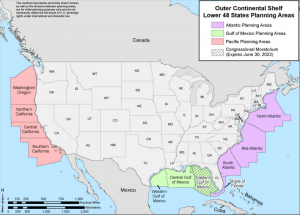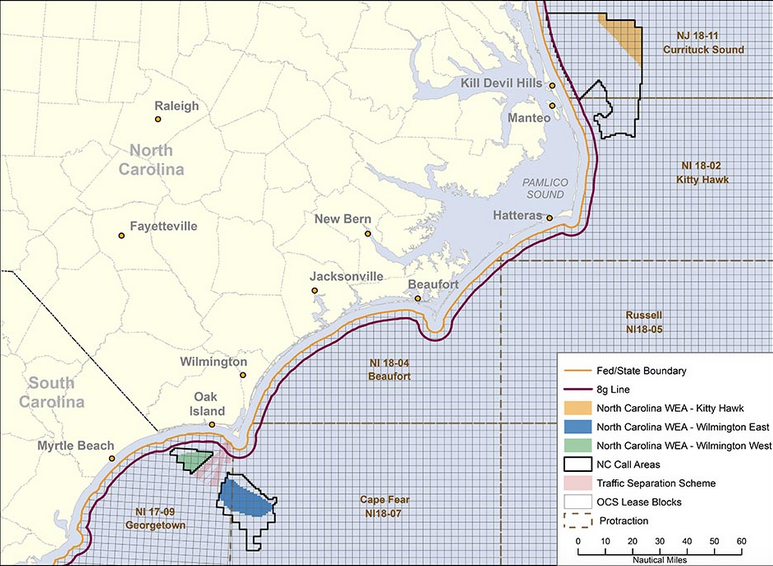Harnessing the Atlantic Ocean’s offshore wind energy potential, especially off the coast of North Carolina, could provide a better path to energy independence and job creation, a report released by ocean conservation group Oceana states.
Andrew Menaquale, Oceana energy analyst and author of the report, spent about nine months collecting and analyzing data on offshore energy potential along the Atlantic coastline to determine how both sources of offshore energy could contribute to American energy independence.
If government estimates of Atlantic oil and gas reserves are accurate, oil would generate enough energy for less than five months of national consumption, while gas would meet less than 10 months of national consumption, the report found; wind energy, it continued, could out-produce oil and gas within 13 years.
“If we commit ourselves to developing offshore wind resources, it could definitely surpass all that we have with oil and gas,” Menaquale said. “And also, keep in mind, once that oil and gas runs out, it’s gone. Offshore wind, well beyond that, will keep producing energy and will continue to power coastal communities.”
North Carolina could lead a shift to wind energy, Menaquale said, because it offers more potential to produce it than other East Coast states.
“That could be the beginning. That could really accelerate the industry,” Menaquale said. About 300,000 acres off the coast of Kitty Hawk and Wilmington could be leased for offshore wind energy development, following an environmental assessment by the U.S. Bureau of Ocean Energy Management.
American Petroleum Institute spokesperson Brian Straessle referred to a report compiled by industry consultant Quest Offshore, which states drilling off the Atlantic coast could yield about 6,000 barrels of oil equivalent each day if operations begin in 2026, increasing to more than 1 million barrels per day by 2035. The Quest Offshore estimates predict North Carolina, which boasts a large portion of the Atlantic Outer Continental Shelf, will see the most offshore oil and gas activity if the Atlantic opens for drilling, generating more than $4 billion in revenue and 55,000 jobs.

The Oceana report estimates wind energy development would spur about 91,000 jobs by 2035. The energy produced by offshore wind farms would stay in North Carolina, Menaquale continued, and contribute to local energy independence.
“That’s typically how offshore wind farms work. They’re going to power the communities that are closest to them. … In comparison, oil and gas drilled off the coast of North Carolina is not going to stay in North Carolina. It’s a global commodity, and it will be bought and sold internationally,” Menaquale said.
Straessle said the country has undergone an energy renaissance over the last five to seven years, and although he cited numbers from the U.S. Energy Information Administration suggesting oil and natural gas will play the largest role in domestic energy consumption in the next 25 years, he said all energy sources should be explored and utilized.
“We believe you really do need an all-of-the-above approach, and that includes wind, that includes oil and natural gas, and all the other forms of energy we use,” Straessle said.
The government originally underestimated oil and gas reserves in the Gulf of Mexico, Straessle said, and expected to find 9.6 billion barrels of oil in 1987 compared to a 2011 estimate of 48.4 billion barrels. Gov. Pat McCrory, who outlined his strategy for exploring offshore oil and gas during an Oct. 22 visit to Wilmington, said his first priority is to conduct seismic airgun testing to determine what resources exist.
“We’ve got to find out if there’s anything there or not, which hasn’t been done. There hasn’t been seismic testing for 25 years. … So my first goal is to find out what we have, and then find out the best way to get to it in a safe, environmentally sound way, if there is a market for it,” McCrory said.
Menaquale agreed that seismic testing could show larger reserves of oil and gas, but pointed to harmful effects of airgun blasts on marine mammals.
“This is just one of those examples where the idea of offshore drilling can harm coastal communities and the marine environment well before a rig is ever put in the ocean,” Menaquale said. Marine vibroseis is a safer alternative to seismic testing, he added.
An August 2014 publication from the ocean energy bureau states that no documented scientific evidence links harm to marine animals and seismic testing.
McCrory also told a crowd in Wilmington that he would not allow offshore drilling in North Carolina unless federal law enables companies drilling in the Atlantic to share revenue with nearby states, which he promised would be passed on to coastal communities to help cover the cost of beach renourishment and inlet dredging.
A revenue-sharing system in the Gulf of Mexico passes a little less than 40 percent of oil and natural gas profits to nearby states, Straessle said.
The ocean energy bureau is expected to release a draft of the proposed 2017-2022 OCS Oil and Gas Leasing Program, a blueprint for offshore oil and gas drilling operations, for public comment in the next few weeks. Oceana hopes the new plan will not open the Atlantic or the Arctic to drilling, Menaquale said.
If the Atlantic Outer Continental Shelf opens for lease sales in the 2017-2022 plan, oil and gas production is not expected until 2026, with exploratory drilling and infrastructure development taking place first.
email [email protected]




